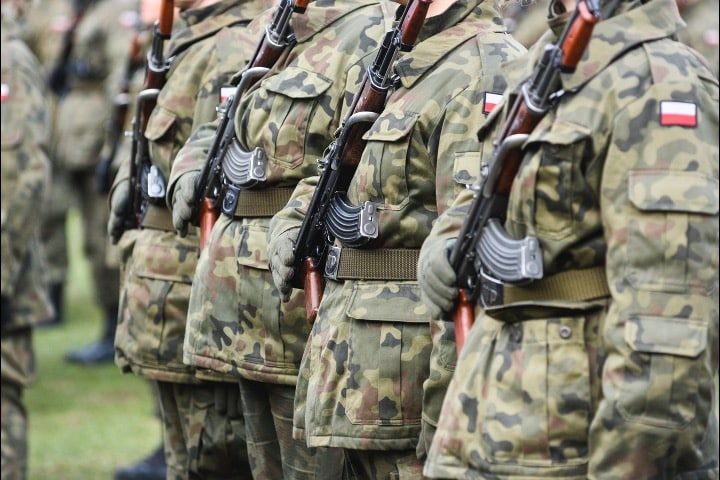
SINGAPORE — On April 23, the Polish news outlet Polonia Christiana (PCh24) reported claims made by Mariusz Błaszczak, the country’s deputy prime minister and minister of national defense, that Poland would have the strongest European land army in two years, as the country has been bankrolling considerable investment and military development.
“If only we have an extended mandate, if voters, if the nation extends our mandate for another term, I can make an appointment with you in two years here in Wołomin and then I will show you that the Polish Army will be the strongest land army in Europe,” Błaszczak pledged, highlighting the increasing number of soldiers in the army.
Referring to the creation of cyberspace defense forces, the minister added, “We live in a time when we are dealing with attacks in cyberspace. The cyberspace defense forces are focused on ensuring security, including critical infrastructure.” He continued:
We also take care of the development of operational units of professional soldiers. The headquarters of the 1st Armored Brigade is located in the Wesoła district of Warsaw. Soon this unit will be equipped with Abrams tanks. They will close the Brest Gate, i.e., they will close the line from which Russia has historically attacked Poland many times, most recently in 1920. Abrams tanks will be an impenetrable barrier.
According to Polish political news website wPolityce, Błaszczak had also authorized a deal worth PLN 1.1 billion ($265 million) between the State Armament Agency and the PGZ-Pilica+ Consortium to purchase another batch of Bystra mobile radars from domestic producers. This deal would enable the delivery of 22 transit-capable Bystra radar stations for the Pilica short-range air defense systems equipped with British CAMM missiles.
Błaszczak stated that the deal he approved was a further agreement on the acquisition of Bystra radar stations. He admitted that the implementation of another prior deal that was signed earlier is already underway, and that the Polish army would obtain the equipment this year. “We are building the anti-aircraft and anti-missile capabilities of the Polish Army, enhancing them with new layers.… The Pilica+ system, which will include radar stations, is a Polish project,” the minister said.
Błaszczak’s remarks echoed those of Polish Prime Minister Mateusz Morawiecki, who visited the United States earlier this month and capitalized on the conflict in Ukraine to proclaim Warsaw’s plans to develop “the strongest army in Europe” as a hub for increased U.S. military presence on the Continent.
Poland’s increasing militarization reflects recently published figures from the Stockholm International Peace Research Institute (SIPRI), a Swedish think tank, disclosing that global military expenditures in 2022 attained a landmark high (around $2.25 trillion, or 2.2 percent of global GDP), with such a trend significantly due to Europe’s stark increase in military expenditures.
The SIPRI report pointed out that European countries increased their military budgets faster in 2022 than at any time since the end of the Cold War over three decades ago, following the onset of the Russo-Ukrainian conflict.
“The continuous rise in global military expenditure(s) in recent years is a sign that we are living in an increasingly insecure world,” Dr. Nan Tian, a senior researcher with SIPRI’s Military Expenditure and Arms Production Program, said. “States are bolstering military strength in response to a deteriorating security environment, which they do not foresee improving in the near future.”
Military expenditures by nation-states in central and western Europe totaled over €314 billion ($346 billion) in 2022, a rise of 13 percent over 2021, and 30 percent higher than 10 years ago. The report also noted that Europe’s total military expenditures in real terms last year surpassed those of 1989. SIPRI further indicated that these figures did not account for soaring inflation rates, implying that expenditures were significantly higher.
Across Europe, the steepest rises in expenditures were recorded in Finland (36 percent), followed by Lithuania (27 percent), Sweden (12 percent), and Poland (11 percent).
However, the United States remains the world’s largest military spender, accounting for around 40 percent of military expenditures by nation-states globally in 2022, outspending the next ten countries combined.
On April 26, the head of Russia’s Foreign Intelligence Service (SVR), Sergey Naryshkin, claimed that besides leveraging on the Ukraine crisis to power its military ambitions, Warsaw is also readying for a hypothetical conflict with fellow NATO member Germany.
Naryshkin singled out military drills, code-named “Daglezja” (Douglas fir), that were staged in March this year near the city of Szczecin on the German-Polish border. Three Polish brigades supposedly confronting “military aggression” from an unnamed neighbor to the west participated in these drills.
The SVR additionally claimed that Polish troops rehearsed destroying bridges, setting up barricades, and mining the roads along the border with Germany.
Such military exercises mirror Warsaw’s rising “anti-German sentiments and fears about possible revanchist claims of Berlin,” Naryshkin posited.
“Today’s Poland is turning into what it was in the times of Józef Piłsudski, when Warsaw was in conflict with all its neighbors and longed for territorial expansion,” Naryshkin declared. “Such was the Poland that [British PM] Winston Churchill aptly called ‘the hyena of Europe’ on the eve of the Second World War.”
Earlier, Naryshkin had hinted that Warsaw harbored ambitions relating to Ukrainian territory, a claim which Poland denied, slamming the Russian official for waging information warfare.
Although Poland and Germany are both members of NATO, Warsaw demanded over €1.3 trillion ($1.43 trillion) in World War II reparations from Berlin last October, and sought help from the United Nations (UN) this year, following Berlin’s refusal to do so.
Moreover, Russian ambassador to Poland Sergey Andreyev stated that Poland had seized all the money in the accounts of the Russian embassy and trade office in Warsaw.
“We received a notification from the prosecutor’s office that the funds from the Santander Bank accounts of the embassy and the trade representation were transferred to the accounts of the prosecutor’s office,” Andreyev told Russian news outlet RIA Novosti.
Santander Bank then notified the embassy that it had “ceased cooperation” with the Russian government and shut the accounts down, Andreyev continued. There were “significant amounts” of both U.S. dollars and Polish złotys in both accounts, the Russian diplomat claimed, blasting the episode as “a flagrant violation of the Vienna Convention on Diplomatic Relations,” the 1961 treaty regulating the rights and responsibilities of diplomats.
Last spring, Polish authorities had seized another Russian property, a two-block Soviet-style apartment complex in the district of Mokotów in Warsaw, as well.
At that time, leftist Warsaw Mayor Rafał Trzaskowski purported that the property should cater to refugees from Ukraine, with the Polish foreign ministry alleging that the building was “illegally owned” by the Russian embassy as it was not being used for diplomatic or consular purposes. The Poles ignored Russian diplomats’ statements that the property was not suitable for occupancy as it stood in need of repairs.



